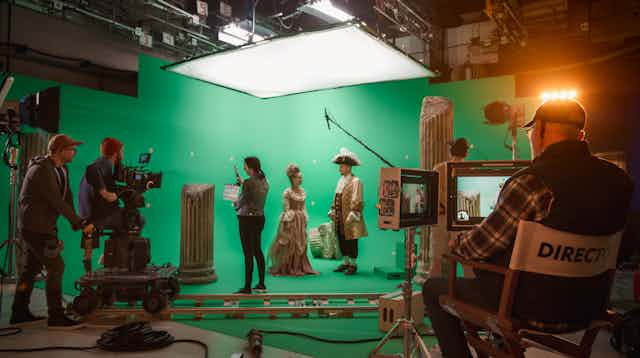So-called method acting seems to be having a moment. Benedict Cumberbatch and Kirsten Dunst apparently didn’t speak to each other on the set of their new film, Power of the Dog, to help them stay in character. While Lady Gaga is said to have spoken entirely with an Italian accent for nine months while working on her new film, House of Gucci – using it even when calling her mother.
Jared Leto is also a fan. While playing the Joker in Suicide Squad, Leto is said to have sent animal carcasses to his castmates. Matthew McConaughey, meanwhile, lost so much weight he started to go blind for his role in Dallas Buyers Club. And Daniel Day-Lewis demanded that production staff pushed him around in a wheelchair and spoon-fed him for his performance in My Left Foot, where he played Christy Brown, a painter born with cerebral palsy.
But not everyone is keen. Actor Martin Freeman recently called out Jim Carrey for his over-the-top antics during the filming of the 1999 film, Man on the Moon, which included “stuffing his pockets with smelly cheese and hanging out with Hell’s Angels”. Freeman said: “It was the most self-aggrandising, selfish, narcissistic fucking bollocks I have ever seen…You need to keep grounded in reality, and that’s not to say you don’t lose yourself in the time between ‘action’ and ‘cut’, but I think the rest of it is absolute pretentious nonsense”.
What is method acting?
While many actors may aim to fully “become” their character with the use of method acting it seems there is a serious misunderstanding of the term and what its founder actually had in mind.
The originator of “the method” was US acting coach Lee Strasberg who crafted an acting technique in the 1930s that he claimed was based on the work of Konstantin Stanislavski, a Russian theatre practitioner. In his book A Dream of Passion, Strasberg stated his belief that “the fundamental work of the actor – the training of his internal skills – is preceded by the development of the actor’s relaxation and concentration”. The goal of these exercises is to “free the expression of the actor” because “neuromuscular tension makes it difficult for thought, sensations, and emotions to be transmitted and properly experienced”.
An exercise in a standard method based training session has the actor sit in a chair and put themselves into a highly relaxed state. They will then explore a memory from their past where they experienced very strong emotions. As the exercise proceeds, the actor describes what they were wearing, what the temperature of the place was like, and how it affected them until they feel the original emotion. Strasberg believed that this exercise created a path for actors to recreate the same emotion over and over, on-demand, with complete control since because it is a “remembered emotion” it will not be felt like a real emotion. It is not about what happened to the actor but rather “what he sees, hears, touches, tastes, smells, and what he is experiencing”.
Essentially, the method actor will be “using his own reality to properly relate to that of the character in the scene”. In short, the actor should behave in a real manner, really performing an action or feeling an emotion rather than pretending to do so. At no point does Strasberg expect a method actor to carry this work outside of the theatre or sound stage, instead, they should be feeling real emotions and behaviours in the performance.
Staying in character
Where confusion seems to set in is with the notion that a method actor should “live the life of the character” full time. This paraphrasing derives from Stanislavski but is incomplete. What he said in his seminal acting text, An Actor Prepares, is: “In our art, you must live the part every moment you are playing it, and every time.” Which is to say, live the life of the character on stage.
Neither he nor Strasberg ever said to go further than that. But, oddly, it’s what many people consider the method to be – immersing the self so deeply, that the actor is no longer “themselves” but this other person. It might be pedantic to say so, but this is not method acting. It is very much something else.
It’s also worth, perhaps, being sceptical of many of the tales of actors immersing themselves so deeply. It makes a great story, but ask yourself if the actor is living the life of a character from 100 years ago, how do they get to the set each day? Do they still carry a smartphone? How do they do their shopping?
Looking more deeply at the Cumberbatch story, Dunst has confirmed that they didn’t speak on set because the characters so despised each other. But she continued: “He’s so sweet. And he’s so British. Polite British, you know? I was like, ‘I can’t talk to you!… We didn’t talk at all during the filming unless we were out to dinner on a weekend, all together, or playing with our kids.”
It seems then that they didn’t speak on set because they and their families were becoming such good friends, they didn’t want that to accidentally colour their performances. This has nothing to do with method acting.

